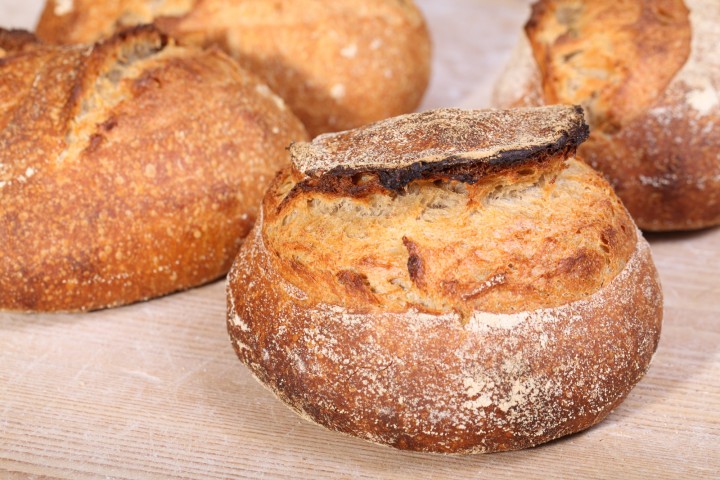
If it bubbles and smells nice…
Klik hier voor Nederlandse versie
These sourdough making and bread baking tips aim to help you with your sourdough bread baking. Maybe you have your sourdough starter culture ready and active. If not, please check out our tutorial on how to make your own sourdough culture in easy steps.
- Time is your friend, time means taste. And compared to yeast based breads you will need much more of it for the dough to properly develop. So, do not make sourdough bread when you are in a hurry, it takes as long as it takes!
- Do not be discouraged if your first sourdough bake is not perfect. This is perfectly normal. Like with all baking you need to learn and get to understand your dough and its quirks in combination with your surroundings, your material and ingredients. Lots of factors that need to come together.
- Start with a good basic sourdough recipe like our Pain Naturel. When this goes well you can get creative. Make the recipe at least a few times as described before changing anything…get to know the recipe and get a feel for the dough.
- Every sourdough culture is a bit different, some take 2 hours to proof your bread, some take 4 hours. So bake a few times to get a feeling of your sourdough culture it may be different from ours.
- Even if your sourdough loaf is not perfect and maybe a bit flat, do not throw it away. Most of the time it will still be very edible!
- You will see a lot of different names for the same thing in recipes in books and on the internet; sourdough, culture, starter, barm, sauerteig, kultur, desem etc. It all means the same; a mixture of water and flour fully alive with wild yeast and good bacteria. Do not be confused, it all works the same! The biggest difference will be the amount of water and the type of flour.
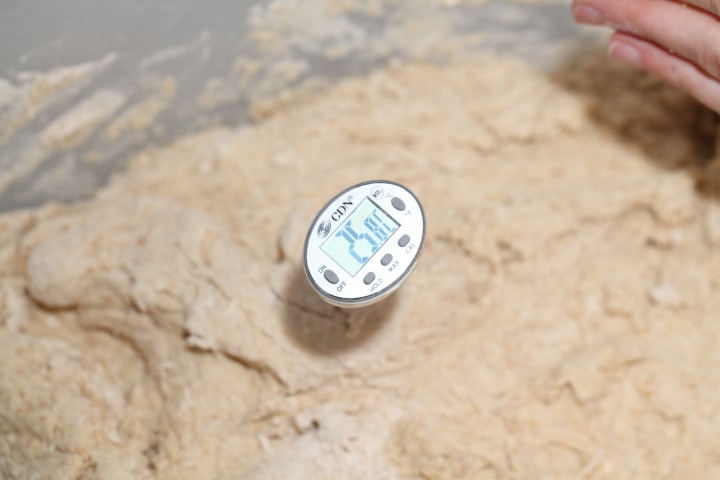
Some basic tips to start with…
Taking care of your sourdough culture
A good sourdough bread can only be made with a sourdough culture that’s alive and kicking. So make absolutely sure:
- You take good care of your starter by refreshing it regularly. When a starter gets too sour the acid stops the yeast from growing and making bubbles. By refreshing you give your starter new food to eat and you dilute the acid environment so the yeast comes back to live again.
- When you do not use your starter for a few days or it is a hot day / week you can store it in the fridge for up to three weeks before it needs refreshing again.
- Your culture smells nice! Your starter should smell fresh and fruity, reminding you of things like blueberries (with rye) and yoghurt and citrus (with wheat). If this smell changes to something resembling nail polish it is definitely time to feed your starter. If the polish smell does not go away…we are sorry but we think it is time to start all over again!
- You stir your starter to help add oxygen to it. The ‘nail polish’ bacteria do not like oxygen but the yeast and the good bacteria like oxygen.
- You use the right flour to feed your culture. Organic whole grain wheat and rye and spelt will work best because these grains will have enough yeast spores to keep your culture going.
- You use the right water too. A sourdough culture does not like chlorine, so if your tap water has too much of it, use bottled water.
- Any signs of fluffy stuff and strange colors on your culture. Something moved in that does not belong. Throw it away and start again!
As long as your sourdough culture is not red, blue, green or black, doesn’t stink so foul you want to run away from it or is growing fluffy hair you can rest assured it is alive and well!
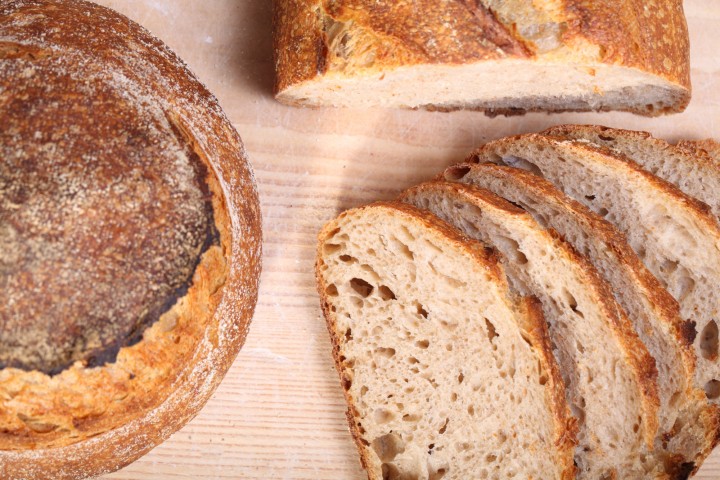
Why do we maintain such a small amount of starter?
We work with a two step system. When using a preferment (like a poolish or a biga) we use about 15-30 grams of sourdough for a sourdough loaf like our whole wheat levain and pain naturel. With this small amount of sourdough you create a fully active sourdough preferment, usually overnight, which you then use to build the final dough. This way you can keep a small starter and still have the full sourdough flavor. Big advantage for home and hobby bakers is you are wasting far less precious flour when refreshing your culture than you would maintaining a big one!
Example: You bake 2 loaves each week. With our method you only have to maintain about 50 grams of sourdough. If you decide to skip baking this week, using our method, refreshing means throwing away only about 30 grams of sourdough. With the other-big-starter-method refreshing means throwing away 200 to 400 grams of culture depending on the recipe! Plus with this method you always need to refresh your starter before baking because the gluten weaken and you would otherwise have all this flour in your dough. With our method, you add the small amount of culture to a fresh batch of flour and so you will not have this problem of weakened gluten in your culture.
More sour please!
There are two main acids produced in a sourdough culture ― lactic acid and acetic acid. Acetic acid, or vinegar, is the acid that gives sourdough much of its sour taste. The lactic acid gives more of a mild yoghurt type of sourness. Giving acetic acid-producing organisms optimal conditions to multiply will yield a culture with more sour notes. Here are some tips to get more sour in your sourdough:
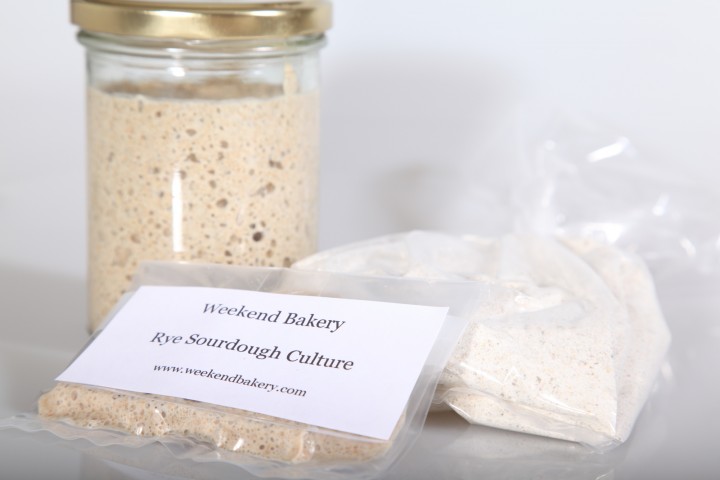
- Maintain your starter at a lower hydration level (more thick paste like consistency). Lactic acid-producing organisms like a wet environment whereas acetic acid is produced more abundantly in a drier environment.
- Refrigerating the culture also slows down the yeast activity and lets the bacteria dominate and produce more sour acids.
- Working oxygen into the starter by mixing during feedings should also promote more acetic-acid sourness.
- Acid-producing bacteria like whole grain flours, so use more of them.
- Try to achieve a longer, slower rise. This may mean you’ll need to create a cooler rather than a warmer environment. You can let the dough rise in a cool place or use the fridge to further retard the dough rising process.
- Sourness also comes with age. If your culture is still very young it may need to ripen a bit more to show its full potential.
Recipe suggestion for a sourdough with more sour tang:
San Francisco Sourdough Bread
No Knead Soft Sourdough Rolls
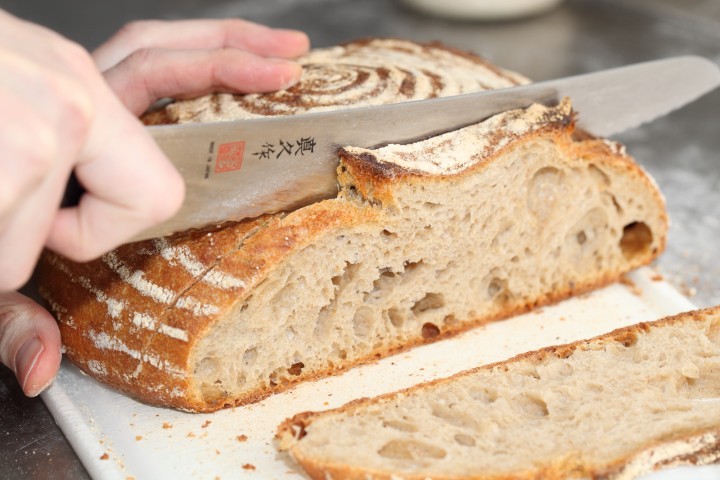
Less sour please!
Don’t want the acidity to hit you full in the face? Stick to these tips to aim for less sour in your sourdough loaf:
- Maintain your starter at a higher hydration level (more yoghurt consistency) and feed / refresh it (more) regularly. This helps to minimize the alcohol content which will help reduce the overall acidity of the sourdough.
- Acid-producing bacteria like whole grain flours, so use less of them and more (finer / white) bread flour.
- Keep your culture at room temperature. The best environment for the yeast and lactobacilli to prosper, but feed regularly!.
- Try to speed up proofing times. You can play with temperatures and amounts of culture added.
- We have found that the sourness depends on the ripeness of the preferment. This means that using an under-ripe poolish gives you the flavor advantages but not the added sourness.
- For a subtle hint of sour and wonderful crust and crumb and a speedier process, check out some of our hybrid bread recipes. They combine the best of sourdough and yeast. Our pain rustique recipe is a good example.
Recipe suggestion for a loaf with less sour tang:
Sourdough Pain Naturel
Sourdough Mini Boules
Starters are like children!
You cannot neglect them or leave them alone for too long plus they are unpredictable. They are all different with their own characteristics and quirky traits.
This is why, despite all the tips given, it can still be that your own culture is a mild and gentle type, never capable of producing a super sour loaf, or the other way around. If all else fails or you are not happy with your results, start a new or second culture and give it another go.
Play with these tips, try different cultures and flours (rye, wheat, spelt) and recipes and see what comes out. It’s all part of the wonderful journey to your ultimate sourdough bread!









Jo says
Hello,
Firstly, I’m really enjoying and appreciating all the information on your website, thank you.
I’m on the last couple of days of making a sourdough culture and I have a question about the container. In the photo yours is extremely clean, mine is not, the sides of the inside of the jar are covered with bits of the culture, I’ve tried to scrape them off while agitating it but it’s very sticky. Do you clean the jars between refreshing the culture or perhaps my culture should have more water added?
Jo (In the UK)
Weekend Bakers says
Hello Jo,
Thank you for your kind words 🙂
You should not worry too much about the clean sides. Our photo’s are ‘a few years back’ and I think we gave it a bit of extra effort back then to make it look nice. Just scrape it down as best as you can, maybe use a silicon spatula for the job. We do not clean the jar between refreshing. But once in a while, you can change and transfer the culture to a clean jar and give the other one a good clean too. Just see what works for you and for the culture. So keep checking it is in good condition. So smell and observe like we say in the tips.
The only reason to change the consistency (add more or less water) is if you want more or less sour (also see tips above).
Wishing you all the best with the baking and a long and active life for the culture!
Greetings from Holland,
Ed & Marieke
Lelani lundgren says
If I want to make 3 loaves do I use 20 grams each 60grams total for pre starter, if mixing all at once. Should I mix all at once or make them one at a time. Thankyou for your time and hope your family is well. First time with this starter it is going well , about to make first loaf, then onto 3 if all goes well, from Duncan British Columbia, Canada
Weekend Bakers says
Yes, you do. If you make 3 loaves you do everything x 3, including the sourdough culture. So make a batch of pre starter x 3 , final dough x 3 and divide the batch of dough in three equal pieces at the final shaping stage.
Hope this answers your question.
Enjoy your sourdough baking!
Greetings from Holland to BC Canada
Karen says
This is a very informative site! I am just beginning my sourdough journey! This is my second attempt. I had to throw my first attempt away as it developed fuzzy white mold .
Weekend Bakers says
Hello Karen,
You did well throwing it away and starting over. You are definitely not the only one, having to give it a few tries, before you get a good culture started. So do not give up and if you get mold again, one thing you can also try is a different sack or brand of flour.
Good luck!
Sara says
This is such an incredible, informative website. Thank you for sharing!
My question is about higher elevations: do you have a recommendation for how much hydration increase? I find I need to add more water but I can never get it quite right! Thanks!
Shane braddick says
Shane braddick says he loves these sourdough tips, thanks!
Katrien Van Bogaert says
Hello i would like to make a sourdough starter, but when or where is the information in Dutch please?
Thanks.
Greetings.
Katrien Van Bogaert
Val says
Hi there I love all your guidance! I’ve only been making bread for a few months and my first loaves were glorious and risen. I was so proud. Then suddenly, with no apparent reason, they stopped rising and were dense and flat. The starter still smells lovely and fruity and the flour (organic whole and light mixed spelt) is always fresh. I tried proving longer then a bit shorter – no difference! Is it me??
Robert Voss says
These are outstanding tips! I have found all this advice to be helpful. One small quibble regarding chlorine in the water. Chlorine is unstable in water. If you fill a quart jar with tap water, set it on top of your refrigerator, uncovered, for a day or two, the chlorine will off-gas nicely. The water is then ready to add to your starter.
Dori Gawan says
Why doesnt my sourdough bread have big holes. Each I make, the holes are like normal bread loaf instead og bigger holes
Weekend Bakers says
Hello Dori,
You can read our tips here to help you with this:
www.weekendbakery.com/posts…eful-tips/
Also try and experiment with different types and brands of flour, this also can make a difference.
Kristin says
I left my pre-ferment too long and it started to deflate. Do I need to start all over?
Weekend Bakers says
Hi Kristin,
It depends, but normally it is not a good idea to use it, because of the weakened gluten. If it has only just started to deflate and it is a relatively low % of the total dough, you can still get a decent loaf.
Sonia says
Can i bake whole wheat or All purpose flour sandwich loaf bread with Rye starter?
Weekend Bakers says
Yes Sonia, you can do that. We do this too, the amount of rye to the total is very small and even has a positive effect on the end result.
osman says
Hi , im confused , some articles are saying it gets less sour in lower temp and some like u are saying its not the temp its the time and if we prove it in hotter place until fully risen, it will b less sour ? I made my 1st started and 1st SD bread and i tasted it before baking ,its very sour lol , i proved it for 12 hours at room temp around 30c i planed to prove it less but it didnt rise so i had to wait more . My started was made on same temp and its more hyrdated half wholewheat half white flour , now its in fridge sleeping 😛 . thnx
Weekend Bakers says
Hello Osman,
It is all of these things, so lower and slower, thicker and ‘older’ will all contribute to more sour. So the fact that it takes longer also produces more sour. So look at what you should do to make it less sour under ‘less sour please’ and try to thick all of the boxes and maybe make your culture even a bit thinner.
Good luck with it!
JJSE says
Hi!
So, I just made your started on Sunday and am looking to use it for two different bakes this weekend. One is rye bread which i know I have enough starter for, 30 g, but the second one requires 100 g of starter. Is it possible to get to a place that I can get 100 g this weekend or should I not try? Also, if it is possible how do I handle the starter in the next several days to get over 130 g? I am on day 3 and will refresh it tonight for day 4. I hope you can help me as I am new to sourdough starter life.
Thanks, JJSE
Weekend Bakers says
Hello JJ,
It is very simple, just make more the day before, let it get active and use it in the recipe, then scale down again. So no steps, just go to the right amount or a bit over in one step.
Good luck with it!
Anne says
Hi Ed & Marieke,
I love to have just a small amount of starter as it doesn’t take up a lot of space in the fridge. But I have some recipes I’d like to try that ask for 100 gr of starter or more. Can I just make a levain the night before and start the recipe with that the next morning? So if the recipe asks for 100 gr 100% hydratation starter, I make a levain with 20 gr starter, 40 gr flour and 40 gr water. Does that equal 100 gr starter?
Thanks!
Weekend Bakers says
Hello Anne,
You can make it the night before and use that in the recipe the next day, so it is nice and active when you use it in the final dough.
The 100% hydration means the levain you add needs to be equal amounts water and flour. And also your levain with 20 gr starter, 40 gr flour and 40 gr water will give you 100 gram starter with 100% hydration (provided the 20 grams starter is also 10 grams water and 10 gr flour).
Enjoy your baking!
Vale says
Hi, thanks for the blog. I have a question. My sourdough starter smells like vinegar (RT 30 celcius), does refreshment of starter to different ratio help?
Weekend Bakers says
Yes, refresh and take a look at the tips above under less or more sour too. Give it a few extra stirs during the day to get oxygen in the culture. Your yeast is indicating it needs new food.
Cliff A. says
I have a question about feeding starter, but also taking some for baking. Suppose I have 90g starter resting in my refrigerator for a week. Now I want to feed it, but I also want some for a batch of bread, say 20g. Which method is better for doing both things?
1. Take 20g of the old starter and put it in the poolish for the bread. Discard 40g more from the jar, leaving 30g in the jar. Add 30g rye flour and 30g water to the jar to feed it (restoring the jar to 90g). Leave the jar out 12 hours, and also ferment the poolish 12 hours.
2. Don’t start the poolish right away. Discard 60g from the jar, leaving 30. Add 40g rye flower and 40g water. Now there is 110g in the jar. Let the starter develop 12 hours. Now take 20g of the active starter for the poolish, and put the jar, with 90g remaining, in the refrigerator for the next baking.
Weekend Bakers says
Hello Cliff,
If, like you say the starter has been sitting in the fridge for a week or longer, we would go with method 2. Within a week method 1 would also not be a problem to use.
Enjoy your sourdough baking!
Steve Smith says
Hi ! Help !
I had my sourdough starter deepfrozen for quite a long time and the other day put it in the fridge to thaw slowly. I then fed it (1:1:1 by weight) and left it at room temparature. It took abut 2 days to “wake up” but then it went crazy – super bubbly. As I wasn’t to use it straight away to make bread, I put it back in to the fridge and after a day something strange happened. The whole mixture separated into 3 parts. At the bottom it looks like flour but with no bubbles or signs of fermetation. Then there is a layer of brownish liquid and on top of that there is the bubbly sourdough that seems to still be alive. I wish I could send you a pic !
What shall I do ? Just use the bubbly part to feed and discard the rest or shall I perhaps start with a fresh starter ?
Weekend Bakers says
Hello Steve,
We think you should have fed your culture sooner. The brown liquid is very probably hooch, a form of alcohol. This is an indication that you should have fed your culture sooner. If the top still smells good and you see no funny stuff in any shape or color as described above, you could try to take part of that and feed it. But at the smallest indication or doubt we would always advice to start over!
Good luck!
rohit aggarwal says
thanks for the information
Erik says
What organic whole grain rye flour do you use? Do you have a link on Amazon or something similar? I am having trouble finding “organic whole grain rye flour” ?
Thanks!
Weekend Bakers says
Hi Erik,
In what country are you trying to buy your flour?
We buy ours at a local mill in Holland.
Jeanette T says
I am in AL and I use Arrowhead Mills Organic Rye Flour. It comes in a 20 oz package that I get from Whole Foods. Does that help?
Have fun baking!!!
Weekend Bakers says
Thanks for sharing Jeanette!
Terrance Scholtz says
The consistency of one’s culture…..does that play an important role as well?????
Weekend Bakers says
Yes, as you can read above in our tips, you can play with the consistency and this will have an effect on the sourness and in the end on the baking results.
Terrance Scholtz says
Awesome tips will put them into play….
Gilly Huntington-Rainey says
Hi there
Great sourdough intel, thanks! I’ve made my starter and am on day 3. Right away on day 1 it doubled, day 2 it trebled! I live in the West Indies so the ambient temp in my kitchen is between 25-28 Celsius, soooo…I put it in the fridge overnight and took it out after about 12 hours. Same mega rise today after feeding. Only took about 1.5hrs to Treble in size. Have stirred it twice so far today. My question is, should I leave it in the fridge or will it be ok on the counter in this temp? It is smelling a little better today and I’m super excited to see what happens!
Weekend Bakers says
Hello Gilly,
Hope all is well with your culture. We advice the fridge for your climate definitely.
We also use the fridge for storing our active culture (way less hot climate in general) and it is the best way to control the process and in your case (maybe) slow it down a bit.
Wishing your culture a very long life and lots of success with baking!
Ivana says
Hi guys,
First of all, thank you for sharing your great tips and experience with us…
Few days ago I have started with my starter and for now everything is going according to your plan.
Can you please help me with part of taking starter from fridge. (I sm preparing for future storage)
If it has been in fridge more than 7 days and needs to be fed before baking you said that it should be taken out of fridge day before and brought to room temperature and fed afkors.
My question is:
1. Do I take the starter out of fridge – bring to room temperate (for couple of hours) – and THEN refresh
2. Take the starter out of fridge – immediatelly refresh cold starter?
I hope you understand me…
My question is do I feed my starter directly out of fridge or wait a few hours on room tempereture and then feed?
Thank you for your kind answer in advance
Weekend Bakers says
Hello Ivana,
We think we understand you. You can take it out of the fridge and refresh immediately. The most important thing is to refresh your culture the day before you want to use it in your recipe, so it will be ready and active the following day. So take it out, refresh it and leave it at room temperature until you use it the following day.
Hope it will be great!
Estevan Gonzalez says
Can I use a dough improver in hybrid leavening doughs?
Thank you!
Weekend Bakers says
Hello Estevan,
Can you tell us exactly what you mean by dough improver? Do you mean ‘flour treatment agents’? We never use any of these ingredients except for the addition of some vitamin C (Ascorbic acid) or home made diastatic malt (see: www.weekendbakery.com/posts…atic-malt/). Both can also be added to hybrid doughs.
Matt says
Very helpful info for a novice sourdough bread baker like myself. Thanks for the tips!
Weekend Bakers says
Glad you find them helpful Matt. Don’t know if you also already have seen our top 12 +1 tips / rules we live by ourselves for all our bakes? www.weekendbakery.com/posts…king-tips/
Enjoy your sourdough baking adventure!